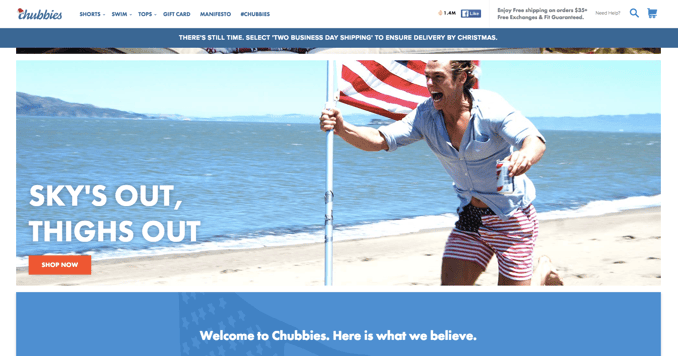Endless scrolling, scrolling, scrolling.
Stop.
Brand voice matters.
In a world of Snapchat, Instagram, and never ending Twitter feeds, your customer needs to fall in love with what you're saying.
What causes the pause? And the click?
Most likely it's an image or short message made up of 164 characters or less. So that message has to communicate A LOT.
Once you've snagged their attention, it's your brand voice, aka the personality of your brand, that causes them to say, "This is just like me," or even better, "This is just how I want to be."
In a perfect world, the reader becomes a member of your community. Your most recent blog posts and emails not only get read, but become a part of their day; something they look forward to.
Of course, writing style plays a major role in developing a brand voice, and we will discuss how to align writing style with brand later in the post. To really develop an amazing brand voice you need to start at the very beginning.
Here's our story...
Lean Labs began as a website development agency. We did well, and made our clients quite a bit of money.
However, we weren’t creating great marketing results. We created some killer apps and websites, but the companies didn't always follow through with the branding. Once we handed over the finished product, our customers struggled to communicate their brand.
While our clients most certainly looked better - with better website design and functionality - our efforts didn’t change their direction.
So, we took a stand.
No longer would we be satisfied with only good looking websites.
We maneuvered, and began to aim toward driving big improvements in traffic, leads, and conversions. Our story begins and ends with a radical commitment to inbound marketing.
We transitioned to an inbound marketing approach to figure out how we could generate more leads and sales for customers - and never looked back. That's our beginning. Find yours and start there on the journey to better branding and discovering your brand voice.
.jpeg?width=640&name=AdobeStock_84441418%20(1).jpeg)
The Genesis of Your Brand
Step 1: Write your introduction, the origin of the organization. Make it short, sweet, and include the values you stand for. Introduce some key characters
How did you come to be? Everyone loves a good story, the quirkier the better. The beginning of the brand often sprouts from a need, a passion, or the simple desire to do something better. It's often something bigger than the individual founders.
Your brand needs to stand for something.
It needs to start from a mission or purpose that is bigger than you. Take the example of Tesla Motors.
By now, it's a fairly well known story: the eccentric, model-dating, billionaire investor that made an electric car both possible AND cool by joining up with a group of passionate engineers. Sure the full story of Tesla is a bit more complicated, but there's not a tech-junkie out there that doesn't want one.
The founders of Tesla passionately wanted to build an electric car, and a GOOD one; despite common wisdom proclaiming a new, independent American electric car company was a pipe dream. This anecdotal beginning is the genesis of the Tesla brand.
Don't Tell a Story, Tell YOUR Story
Step 2: Start with the simplest description
In Step 1, we described the origin of a brand.
Now for the rest of the story. In a concise style, answer these questions:
1. Why is your product or service important? Why does it have to get built?
2. What does your solution provide to the customers you attract?
3. What's the alternative? What would happen if you didn't create this solution?
Using Lean Labs as the example again: Lean Labs exists for one purpose. We fill the gaps that brands have in their business, so our customers can get back to doing things that make them happy and improve their lives. Our goal is simple. Instead of creating websites with surface level branding; we build robust stories, developing a deeper connection between our clients' businesses and customers.
It's More Than Writing Style: Does your brand have a voice?
Step 3: Define your voice in 3 adjectives
Writing style is not the brand voice. Most blogs, email, and social media currently follow a conversational tone, with lingo to match the community's speech patterns. The brand voice can be broken down into adjectives at it's simplest form.
Think, if you had a document that said, “My Brand, Personified,” what would that look like? Start by picking three descriptive words for your brand; such as "Aggressive, Confident, Flashy" or "Smart, Creative, Hipster."
Step 4: Answer 7 Questions to Define Character Definition
First, craft the brand voice. In the next phase, personify the brand and make it into a character.
Membership is exclusive....when the character is fully flushed out, you can start developing a community around it.
Chubbies knows how to rock a character. They even slap their "manifesto" right on the homepage. Two seconds on their site, and you know exactly who the Chubbies character, buyer, and community are.
 photo via: https://www.chubbiesshorts.com/
photo via: https://www.chubbiesshorts.com/
7 Steps to Character Definition
1. Who is the character?
2. What’s the back story of the character of this brand?
3. What are they really passionate about and what are they polarized against?
4. Who is the leader and what do the characteristics of the brand voice say about the brand?
5. How is your character positioned? Are they an adventurer, an evangelist, the reluctant hero?
6. Is it us vs. them? Is it a before and after? Is it thinking about sharing all of your discoveries on a journey?
7. Sometimes you identify the character flaws and write about them. Become relatable.
Tip: Including SEO Throughout
Include tactical work along the way by considering keywords and phrases your character might use. Write them down in a google doc to be used for future SEO work and fuel blog post ideas.
Create Story Lines for Your Brand
Step 5: Guidelines for Storyline Creation
Once the character is defined, write them a story. The power of a great story is that it connects emotionally and sticks with you; perhaps even changes your views.
Brand storytelling achieves the goal of deepening the relationship between your brand and your customer.
What does that really mean? The initial introduction of the brand triggers your lead's interest, but the story on your landing page keeps them there. In this storytelling phase, create story lines that keep them engaged and reading.
Follow these guidelines for best results:
1. Rely on emotion
2. Have a problem; insert tension
3. Make your character the hero
4. Keep it concise and exciting
5. Follow a pattern: Intro, Struggle, Discovery, Resolution
Now Make Your Brand Engaging: Here's How
Step 6: Top 4 Tips to Drive Brand Engagement
This is where things become more tactical. Your character and stories are put to work as tools to drive engagement.
1. Embed Your Character & Brand
Now is not the time to fall back on a flashy website. Get personal. Employ the use of personal names in your email, so subscribers get an email every week from "Sarah at XYZ Company" and come to look forward to what has happened in her world over the last week.
2. Create a Community
Engagement depends on a gathering place. Create one. One possibility is encouraging comments and responding back in the blog. Online news sites such as Jezebel and the Huffington Post are good examples thriving communities "living" in comments sections. By encouraging "membership" in the brand community you are deepening the relationship. A feeling of belonging keeps readers engaged.
3. Use Your Customers
Customers are your best form of engagement. Rely and encourage them to be your evangelists. Customers also make the perfect third party story line. Let them tell how your service helped them achieve a goal or solve their problems. Readers will eat up the emotional story and increase their engagement and trust because someone else with the same problem just told a story they can believe in.
4. Develop Offers to Keep them Involved
Finally, give them a temptation. Appealing offers, great content and contests are all tactics to keep your brand a daily part of your customers lives.
The Competitive Landscape & Its Effect on Brand
Step # 7: Make your Brand Stand out in the Competitive Market
The competitive landscape definitely plays a role in how your brand voice is developed. What sets your product apart? Why does your product have 5 features instead of 7 like your competitors'? What market segment are you going to lead?
Answering these questions about what is going on competitively in the marketplace you've chosen, will assist in differentiating your brand voice. In an ocean of fish, you need to be the biggest whale, or most beautiful starfish.
Over the course of our journey at Lean Labs, we've noticed a common problem. Waterfall websites that just keep going on and on with endless iterations. Continuous delays to any real learning or improvements, and endless tweaks and edits trying to reach perfection.
The perfect website is not the solution to your branding problem.
The decision to call ourselves Lean Labs, stems from an idea to develop our company around lean principles. We believe in agile, continuous improvement, and working in sprints to get there. Waiting for the "perfect website" will keep you waiting a long time. Our goal is to get something up that works well and continue to improve, learn, and test our ideas to provide value as quickly as possible.
Our brand developed not from just doing the work, but acknowledging it within our competitive environment. You have to built it, learn from it, and get better faster than your competitors are.
Be Exclusive & Take a Stand
Step #8: Make Your Choices & Stand by Them
Polarity. Take a stand. Brands cannot succeed if they try to be everything to everyone. The best way to stand out in your market is to have an opinion.
Here are some examples of how you can achieve that:
- Are you the person that did it first and are leading the market? Claim your ownership.
- Sometimes it’s "us vs them." You’re the little guy; the big guys are doing it wrong and you exist to prove that. You’re the clear alternative; make a claim of where you fit and gather a tribe.
- Are you the adventure or the crusader - and this goes back all the way to the beginning; what the brand stands for. You're on a journey to accomplish something huge. Many non-profits fit this mold. They might stand behind the mantra, "We’re going to solve world hunger" not, "We hope to solve world hunger." The Bill and Melinda Gates Foundation is the perfect example.
- Perhaps your company fits "The reluctant hero." You didn’t intend to be in this business, but no one else did it. Growth Hackers fits this character. They built their product to use themselves because they couldn't find the functionality they needed.
Potential Pitfalls of Brand Voice
Beware of these common pitfalls along the way: there are many stories of branding gone wrong.
Burger King for example, suffered for years to gain footing in the fast food market. Part of their problems were based on the following:
No Polarity
You can't please everyone. Trying to water down messaging to appeal to the masses rarely succeeds.
The Wrong Polarity
Burger King's weird, scary King was designed to appeal to a certain "Frat boy" humor that quite honestly just came across as kind of gross. In this example, Burger King simply lost it's way.
Lack of Clarity & Commitment to the Brand
Your brand voice needs to be focused and carry through. If not, there’s an internal gap.
Here's a test. Choose your closest competitor. If you copy and pasted your home page content to theirs, could you tell the difference?
If the brand voice is clear and committed to the story and characters you've developed, that’s not possible.
ITA is an example of a brand with a clear voice; they want to help young millennials travel, teach english, and figure out who they become in the process. They help facilitate the adventure of a lifetime, and prove that there is no better time for it than now.
Greediness & Insincerity
This problem occurs when you drop brand voice in favor of the hard sell. Take the time to develop the relationship and provide customers some guidelines for how things will progress. Don't rush them to the alter before you've had time to propose.
Inconsistent Writing Style
Create a document that describes the writing style and include samples. This is a simple fix, but a noticeable change in writing style can undermine the relationship before it begins.
The Brand Voice: Discovered
Developing your brand voice takes effort. The creation of a consistent voice, recognized in every campaign, email, and post, is the primary driver of the relationship between your organization and your customers. It is fluid and may change over time. Pop culture, news stories, and the passage, and the evolution of your brand can affect your brand voice - it evolves with your brand.
The steps we discussed above will help frame your voice, provide the building blocks, if you will.
It's up to you to add all the other human elements. Once discovered, you will find your brand voice is easy to adjust as needed, and your customers will reward the effort with their loyalty.
At Lean Labs, we're still working on perfecting our voice. It's a path to discovery and well worth the effort. If you've got an organization with an amazing solution and cutting edge technology but no customers, take a close look at your brand. Follow the 8 steps outlined above to rediscover the messaging that's been lost along the way! The payoff is worth it.

.jpeg?width=640&name=AdobeStock_84441418%20(1).jpeg)





